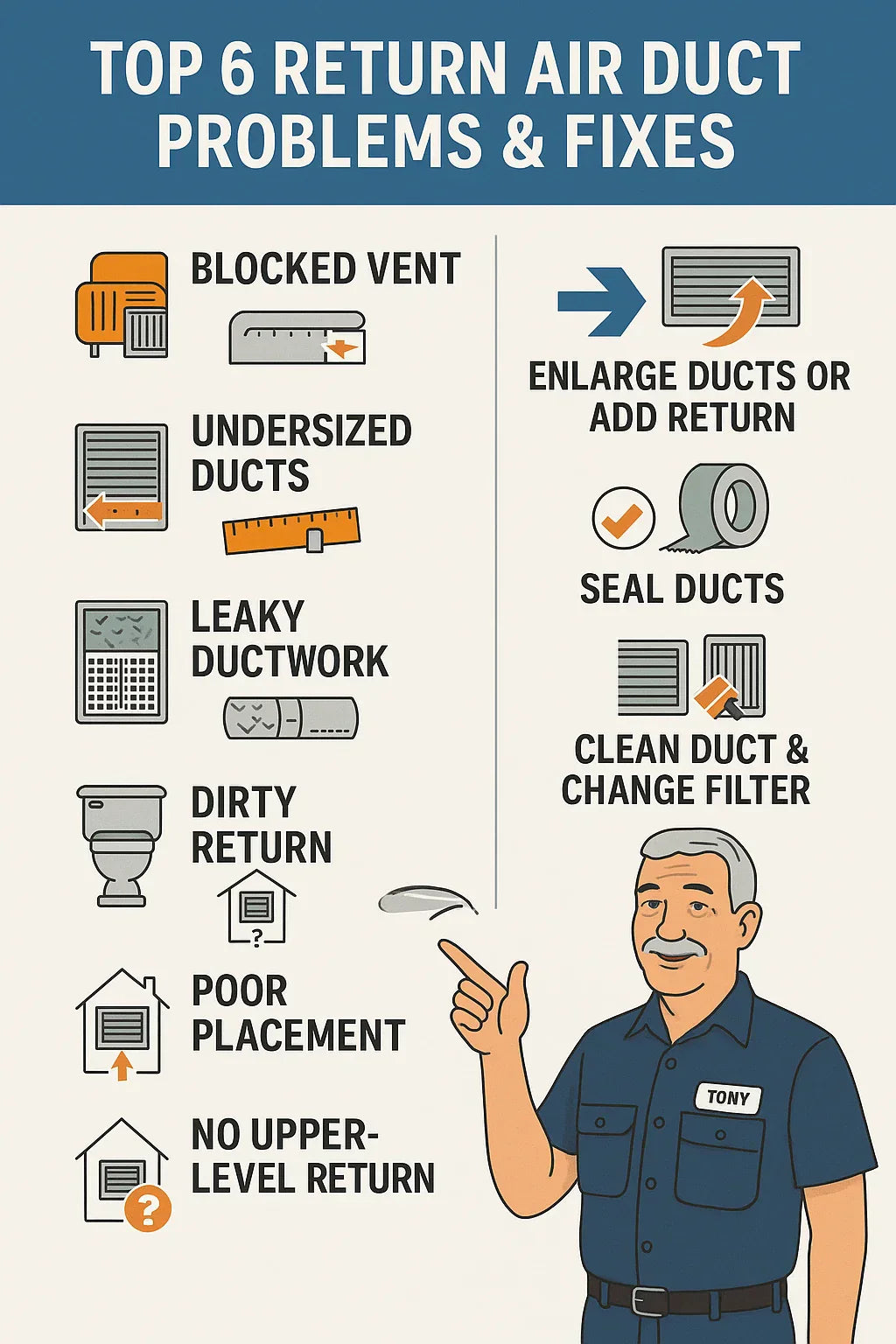🔧 Why Return Air Ducts Are So Important
👨🔧 “Tony here. Most folks only notice the supply vents blowing cold or warm air. But the truth is, return ducts are just as important—maybe more so. Without strong returns, your HVAC system’s like trying to run a marathon while breathing through a straw.”
Southwark 811 Return Air Duct for 20x10-25x16 Sizes
Here’s what return ducts do:
-
Balance airflow: Keeps supply and return equal.
-
Filter pollutants: Air passes through filters before recirculating.
-
Maintain efficiency: Proper airflow prevents blower strain.
-
Control comfort: Ensures even temperature distribution.
📎 Trane explains return air vents are key for balanced airflow and efficiency.
🚫 Common Return Air Duct Problems
🚪 Blocked or Covered Vents
-
Furniture, rugs, or drapes often block returns.
-
Airflow restricted → pressure imbalance + reduced efficiency.
👨🔧 “I once found a sofa pushed right against the only return vent in a living room. Customer wondered why the room felt stuffy. Moved the couch six inches—problem solved.”
📐 Undersized Ducts or Grilles
-
Grilles or ducts too small for system’s airflow demand.
-
Results: whistling sounds, pressure imbalance, blower strain.
🔩 Leaky Return Ducts
-
Common in attics, basements, or crawlspaces.
-
Pulls in dusty, humid, or polluted air.
-
Leads to poor IAQ (indoor air quality) + higher energy costs.
📎 Energy.gov confirms duct leakage is a leading cause of energy loss.
🧹 Dirty or Dust-Clogged Returns
-
Clogged filters not changed regularly.
-
Dust, lint, and pet hair line the ducts.
-
Airflow suffers + allergens circulate.
📎 EPA notes duct cleaning matters if visible dust, mold, or pests are present.
📍 Poor Placement
-
Returns in bathrooms, kitchens, or laundry rooms.
-
Pull in odors, humidity, grease, or chemicals.
-
Causes musty smells + mold growth.
🏠 No Return on Upper Floors
-
Two-story homes often have only one central return.
-
Results: hot upstairs in summer, cold upstairs in winter.
🔊 Noisy or Whistling Grilles
-
Undersized grilles force air through too small an opening.
-
High static pressure creates whistling noise.
👨🔧 “If your return grille sounds like a tea kettle, it’s too small. Replace it with a larger one and let that system breathe.”
🛑 Unsealed Ductwork Drawing Bad Air
-
Returns pulling attic, crawlspace, or garage air.
-
Introduces dust, insulation particles, fumes, or moisture.
-
Bad for health + comfort.
📎 ASHRAE emphasizes proper duct sealing for healthy indoor air.
🛠️ How to Fix Each Problem (DIY & Pro Solutions)
Blocked Vents
-
DIY: Move furniture, rugs, curtains.
-
Pro: Add additional return if airflow still weak.
Undersized Grilles
-
DIY: Upgrade to larger grille.
-
Pro: Add more returns or resize ductwork.
Leaky Returns
-
DIY: Seal small leaks with foil tape/mastic.
-
Pro: Duct blaster test + full resealing.
Dirty Returns
-
DIY: Vacuum + replace filters every 1–3 months.
-
Pro: NADCA-certified duct cleaning every 3–5 years.
Poor Placement
-
Pro fix only: Relocate returns to hallways, bedrooms, living rooms.
Missing Upper-Level Returns
-
Pro: Add new duct runs upstairs. Costs $500–$1,200 each.
Noisy Grilles
-
DIY: Upgrade to larger grille.
-
Pro: Resize duct system for proper CFM.
Unsealed Ductwork
-
DIY: Seal visible seams.
-
Pro: Full duct sealing + insulation.
💨 The Science of Airflow & Why These Problems Happen
Your HVAC system needs 400 CFM of airflow per ton of cooling. Example:
-
3-ton system = 1,200 CFM total airflow.
-
One 20x20 return grille handles ~800 CFM.
-
If that’s your only return → system starved.
Airflow balance is like a see-saw:
-
Too much supply → positive pressure, air leaks out.
-
Too much return → negative pressure, air sucked from attic/basement.
👨🔧 “I’ve measured homes pulling crawlspace air straight into the system. Families thought it was ‘seasonal allergies’—nope, just duct leaks.”
📎 Energy Vanguard explains return air pathways are critical to airflow balance.
💵 Cost of Repairs: DIY vs. Hiring a Pro
| Problem | DIY Fix Cost | Pro Fix Cost | Notes |
|---|---|---|---|
| Blocked Vents | $0 | $200–$500 (add extra return) | Often solved by rearranging furniture |
| Undersized Grilles | $30–$80 | $300–$1,200 | Pro may resize duct |
| Leaky Returns | $10–$50 (tape/mastic) | $1,000–$2,000 (whole sealing) | ROI high for energy savings |
| Dirty Returns | $20–$50 | $300–$500 (deep cleaning) | NADCA-certified pros only |
| Poor Placement | – | $1,000–$2,500 | Requires new duct runs |
| Missing Upper Returns | – | $500–$1,200 per return | Essential for two-story homes |
| Noisy Grilles | $30–$80 | $200–$500 | Larger grilles usually fix |
💡 Tony’s Pro Tips to Prevent Future Issues
-
Change filters every 1–3 months.
-
Use MERV 11–13 filters for dust/allergens.
-
Inspect ducts every 2–3 years.
-
Seal attic/basement duct seams with mastic.
-
Don’t put returns in kitchens or bathrooms.
-
For large homes: aim for 1 return per 500–600 sq. ft.
👨🔧 “Spend $20 on filters regularly or spend $2,000 fixing ducts later. Easy choice.”
❓ FAQs About Return Air Problems
Q: Why does my return vent whistle?
Because it’s undersized. Upgrade to larger grille.
Q: Can I close return vents in unused rooms?
No—returns must stay open for proper balance.
Q: Is duct tape okay for sealing leaks?
No—foil tape or mastic only.
Q: Do I need a return in every bedroom?
Not always, but bedrooms with closed doors benefit from returns.
📌 Final Word from Tony
👨🔧 “Nine out of ten comfort complaints I see aren’t because of the furnace or AC—they’re because of bad return ducts. Whether it’s blocked, leaky, or undersized, a weak return starves your system. Fix the airflow, and you fix the comfort. Simple as that.”
In the next topic we will know more about: Return Air Duct Upgrades: When to Replace or Resize for Efficiency







